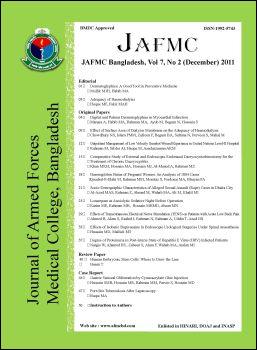Effect Of Surface Area Of Dialyzer Membrane On The Adequacy Of Haemodialysis
DOI:
https://doi.org/10.3329/jafmc.v7i2.10387Keywords:
Haemodialysis, dialyzer membrane, durationAbstract
Introduction: Patients with end stage renal disease require 12 hours of haemodialysis per week in three equal sessions (4 hours/day for 3 days/week). But the duration and frequency of treatment can be reduced by increasing the surface area of the dialyzer membrane.
Methods: In this prospective study 40 patients of end stage renal disease receiving haemodialysis for more than six months were included to observe the effects of increment in the surface area of the dialyzer membrane on the adequacy of haemodialysis.
Result: It was observed that 20 patients receiving haemodialysis on a dialyzer with membrane surface area of 1.2 m² did not have satisfactory solute clearance index. Urea reduction ratio was 45.9 ± 3.03 and fractional urea clearance (Kt/V) was 0.76 ± 0.09. On the other hand patients (20 cases) receiving haemodialysis on a dialyzer with membrane surface area of 1.3 m² had a urea reduction ratio 50.76± 5.16 and fractional urea clearance (Kt/V) 0.91 ± 0.16. All the patients of both groups received dialysis for 8 hours/week in two equal sessions (4 hours/day for 2 days/week). Statistically the increment was significant (p<0.001).
Conclusion: This study reveals, adequacy of dialysis can be increased by increasing the surface area of the dialyzer membrane. So, considering the poor socioeconomic condition of Bangladesh and patients' convenience, a short duration, low cost dialysis regime can be tried by increasing the surface area of dialyzer membrane.
DOI: http://dx.doi.org/10.3329/jafmc.v7i2.10387
JAFMC 2011; 7(2): 9-11
Downloads
678
956

